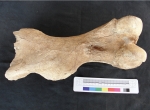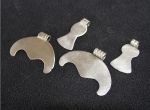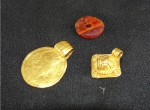Excavating the Hanging Cave – a progress report
2015.09.01 -
The third season of excavation of the cave site at Kroczyce, Zawiercie district, is now in progress. This year the core team has been recruited from the Warsaw University Institute of Archaeology and the Faculty Artes Liberales staff and students of the undergraduate and the doctoral courses, led by Marcin Rudnicki.
The excavation of a deposit dated to the middle of the 1st millennium AD led to the discovery of fragments of at least six human skeletons, a large quantity of wheel-thrown pottery, glass beads and an amber pendant, evidence on the presence during the Migration Period of newcomers from the northern coast of the Black Sea, possibly from the Gothic communities established in Ukraine. A major sensation was the discovery of cremation burials near to the cave entrance. The circumstances of the presence in our region of a group of arrivals from so far away is still a puzzle. We expect to understand the nature and the duration of this episode better with the help of input from a paleobotanic analysis of samples obtained from the culture deposit.
This year the team at Kroczyce was joined by a group of archaeologists and anthropologists specialized in the earliest evidence on the human presence in the territory of Poland. A 4-metre deep trench excavated inside the cave yielded an impressive stratigraphic sequence from the Pleistocene containing a rich assemblage of bones of the cave bear, the woolly rhinoceros and the horse. The number of caves with a similarly rich Quaternary stratigraphy in Poland is very small.
Other participants in this year’s fieldwork season include the staff and students from the V. N. Kharkiv National University in Ukraine led by dr. Kyrylo Myzgin, Jason Williams-James from Wales, Peter de Costa from Bangladesh and Nitin Gupta from India.
-
 full resolution
full resolution
Fig. 1. A woolly rhinoceros humerus.
-
 full resolution
full resolution
Fig. 2. Silver pendants, AD 4th century, provenanced to the Black Sea region.
-
 full resolution
full resolution
Fig. 3. Amber pendant, gold pendant, looped solidus.


